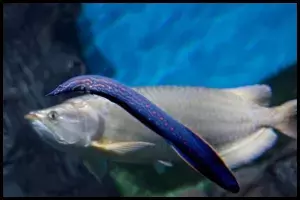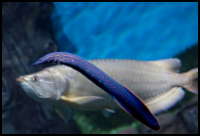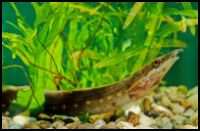




Quick Care Details (Table)
| Livestock Characteristics | Value |
|---|---|
| Care Level | Moderate |
| Temperament | Semi-Aggressive |
| Diet | Carnivore |
| Maximum Size | 2ft |
| Minimum Tank Size | 125 Gallons |
| Plant Safe | Yes |
| Temperature Range | 75-82F |
| PH Range | 6.8-7.2 |
| KH Range | 10-15 |
Species Specific Categories
Helpful Video
Care Details
Aquascape:
- Provide ample hiding spots using driftwood, rocks, and caves.
- Create a dimly lit environment to reduce stress and promote natural behavior.
Substrate:
- Use fine sand or smooth gravel to prevent abrasions on their delicate belly.
Disease Prevention:
- Quarantine new additions to prevent introducing diseases.
- Maintain excellent water quality and conduct regular water changes.
Filtration:
- Employ a reliable filtration system to keep water clean and well-oxygenated.
- Consider a canister filter to minimize water flow that might stress the eel.
Lighting:
- Utilize subdued lighting to mimic their natural habitat.
- Avoid overly bright lights that can stress the eel.
Water Flow:
- Maintain gentle water flow to prevent stressing the eel, as they prefer calmer waters.
Hardiness:
- Fire Eels are relatively hardy, but they require stable water conditions.
- Keep water parameters consistent to prevent stress-related illnesses.
Acclimation:
- Gradually acclimate the eel to new water conditions using a drip method.
- Avoid sudden changes in temperature or water chemistry.
Special Requirements:
- Fire Eels are nocturnal; provide hiding spots and subdued lighting during the day.
- Offer a varied diet of live and frozen foods, as well as sinking pellets.
Temperament and Behavior
Behavior and Social Interaction:
- Fire Eels are solitary and nocturnal creatures, most active during the night.
- They have a shy and reclusive nature, often hiding during the day.
- Due to their nocturnal behavior, they may appear less interactive during daylight hours.
Aggression:
- Fire Eels are generally peaceful and not aggressive towards other fish.
- They might become territorial if their hiding spots are invaded or if they feel threatened.
Breeding:
- Breeding Fire Eels in captivity is extremely rare and challenging.
- Their reproductive behavior and requirements are not well-documented.
Compatibility:
- Fire Eels are compatible with peaceful and non-aggressive tank mates.
- Avoid housing them with fin-nipping or aggressive fish that might stress them.
Activity Level:
- Fire Eels are relatively slow swimmers and spend a lot of time hiding.
- Their nocturnal behavior means they are most active during the night.
Clean Up Crew:
- Fire Eels are not effective members of a clean-up crew.
- They are not known to eat algae or leftover food, and their feeding habits are primarily carnivorous.
Schooling or Shoaling Behavior:
- Fire Eels are solitary fish and do not exhibit schooling or shoaling behavior.
- They prefer having their own territory and space within the aquarium.
Diet and Nutrition
Dry Foods:
- Fire Eels might accept sinking pellets or granules.
- Ensure the pellets are appropriately sized for their mouth and sink quickly.
Frozen Foods:
- Offer frozen foods like bloodworms, brine shrimp, and daphnia.
- Thaw the frozen foods before feeding to prevent digestive issues.
Live Foods:
- Fire Eels have a strong preference for live foods like earthworms, blackworms, and small feeder fish.
- Live foods can stimulate natural hunting behavior and improve their diet variety.
Vegetables:
- While primarily carnivorous, some Fire Eels might nibble on blanched vegetables like zucchini, spinach, or cucumber.
- Vegetables should be offered as occasional treats rather than a primary diet.
Algae:
- Fire Eels are not algae-eaters; they do not consume algae as a significant part of their diet.
- Focus on providing protein-rich foods to meet their nutritional needs.
Feeding Schedule:
- Feed Fire Eels once a day, preferably in the evening when they are most active.
- Offer an amount of food they can consume within a few minutes to avoid overfeeding.
Supplemental Foods:
- Occasionally supplement their diet with high-quality foods like bloodworms, brine shrimp, and other protein-rich options.
- Variety ensures a balanced diet and prevents nutritional deficiencies.
Tank Parameters
Tank Size:
- Provide a spacious aquarium with a minimum capacity of 75 gallons.
- A larger tank will offer more swimming space and reduce stress.
Tank Length and Measurements:
- Opt for a tank with dimensions that allow the Fire Eel to stretch out comfortably.
- A tank with dimensions around 48 inches (120 cm) in length is suitable.
Species Maximum Size:
- Fire Eels can reach sizes of 16 to 20 inches (40 to 50 cm) or more in captivity.
- Choose an appropriately sized tank to accommodate their potential growth.
Water Temperature:
- Maintain water temperature around 75-82°F (24-28°C).
- Keep the temperature stable to prevent stress and health issues.
pH (Acidity/Alkalinity):
- Maintain pH levels around 6.5-7.5.
- Aim for a stable pH within this range to avoid pH fluctuations.
KH (Carbonate Hardness):
- Aim for a KH of 4-8 dKH.
- Carbonate hardness helps stabilize pH levels in the aquarium.
GH (General Hardness):
- Aim for a GH of 4-10 dGH.
- General hardness affects the overall mineral content of the water.
Nitrate (NO3) Levels:
- Keep nitrate levels as low as possible, ideally below 20 ppm.
- Regular water changes and proper filtration help maintain low nitrate levels.
History, Popularity, History and Species Variety Details
The History, Popularity and Habitat
History:
The Fire Eel (Mastacembelus erythrotaenia) is a captivating freshwater fish that hails from Southeast Asia, particularly regions like Thailand, Cambodia, and Malaysia. It belongs to the family Mastacembelidae, which comprises a diverse group of elongated, snake-like fish known as spiny eels. The Fire Eel's scientific name, "erythrotaenia," hints at its vibrant appearance.
Popularity:
Over the years, the Fire Eel has gained popularity among aquarium enthusiasts and hobbyists due to its unique appearance and intriguing behavior. Its striking body coloration, marked by a stunning combination of dark background hues and vivid red lateral lines, contributes to its appeal. The Fire Eel's graceful swimming style and nocturnal behavior also add to its allure. However, due to its size and specific care requirements, it's considered an intermediate-to-advanced level fish to keep successfully.
Habitat:
In its native habitat, the Fire Eel can be found in slow-moving freshwater systems such as rivers, streams, and shallow ponds. These habitats often have ample vegetation, submerged logs, and roots that provide hiding spots for the eels during their nocturnal activities. The eel's elongated body and streamlined shape enable it to navigate through dense aquatic vegetation and find shelter.
The water in its native habitat tends to be warm and slightly acidic to neutral, with temperatures ranging from 75 to 82°F (24 to 28°C). Water parameters can vary based on the specific location within its range. Fire Eels are accustomed to areas with moderate water flow, and they prefer calmer, dimly lit environments during the daytime.
While their natural habitat includes various water bodies across Southeast Asia, the eel's striking appearance and intriguing behavior have made it a sought-after addition to home aquariums worldwide.
Similar Types of Eels You Might Want To Consider
- Tire Track Eel (Mastacembelus armatus): Also known as the Zigzag Eel, this species has a similar elongated body shape and spiny appearance. It's named after the distinctive tire track-like markings along its body. Tire Track Eels are known for their reclusive nature and nocturnal behavior.
- Peacock Eel (Macrognathus siamensis): This eel species has a unique appearance with intricate patterns and colors on its body. It's smaller than the Fire Eel and is often kept in community tanks. Peacock Eels are also burrowing fish that prefer hiding during the day.
- Spiny Eel (various species): The term "spiny eel" encompasses a wide range of eel species that share the spiny appearance and elongated body shape. While there are different types of spiny eels, some may have similar care requirements to the Fire Eel, including the need for hiding spots and a suitable diet.
- Zigzag Eel (Mastacembelus armatus): This eel species, also known as the Tire Track Eel, has a similar body shape to the Fire Eel. It has distinctive zigzag-like patterns on its body, and like the Fire Eel, it's primarily nocturnal and enjoys hiding in substrates.
Common Tank mates for the Fire Eel
Giant Gouramis: Larger Gouramis, often referred to as "giant" or "true" gouramis, are a group of freshwater fish known for their impressive size and diverse colors. These gouramis belong to the Osphronemidae family and are characterized by their labyrinth organ, allowing them to breathe air directly from the surface. With sizes ranging from 6 to 12 inches or more, these gouramis command attention in larger aquariums.
Plecos: Plecos, also known as Plecostomus or "suckermouth catfish," are a diverse group of freshwater catfish known for their distinctive appearance and useful role in aquariums. These fish belong to the Loricariidae family and are characterized by their flattened bodies, armor-like plates, and a ventral mouth adapted for rasping on surfaces.
Discus: are renowned for their stunning coloration and graceful presence in freshwater aquariums. Belonging to the Cichlidae family, they originate from the Amazon River basin. Discus exhibit a distinctive, round body shape and are available in a wide array of colors and patterns.
Angelfish: are iconic freshwater aquarium fish known for their graceful appearance and triangular body shape. These cichlids are admired for their distinctive finnage and come in various colors and patterns, making them a favorite among aquarium enthusiasts.
Male gender vs Female gender (Sexual Dimorphism)
- Size Comparison: In many cases, female Fire Eels are larger and more robust than males. However, this method may not always be accurate as size variations can occur based on genetics, age, and overall health.
- Vent Identification: Venting is a common method used to determine the gender of eels. You'll need to observe the vent area (the opening behind the pelvic fins) to look for differences:
- Males typically have a more pointed and elongated vent.
- Females often have a rounder and wider vent.
- Pectoral Fin Differences: Some sources suggest that males may have slightly longer and more pointed pectoral fins compared to females. However, this can be subtle and might not always be reliable for identification.
- Behavioral Observations: During breeding periods, male Fire Eels might exhibit more aggressive behavior and territoriality as they compete for the attention of females. This behavior could indicate the presence of males in the tank.
- Experience and Expertise: Accurately determining the gender of Fire Eels can be challenging, especially for beginners. Consulting with experienced aquarists or breeders might help you gain insights and guidance based on their observations.
Breeding The Fire Eel In Your Aquarium
- Create Optimal Conditions:
- Provide a spacious aquarium with suitable hiding spots like caves, PVC pipes, or hollow logs. Dim lighting and subdued water flow mimic their natural habitat.
- Maintain water temperature around 75-82°F (24-28°C) and stable water parameters within acceptable ranges.
- Pairing:
- Introduce a potential breeding pair to the breeding tank. Select mature and healthy individuals with similar sizes.
- Ensure the tank has visual barriers to reduce stress between the pair.
- Conditioning:
- Feed the pair a varied and nutritious diet to improve their overall health and readiness for breeding.
- Include live foods like blackworms, bloodworms, and small feeder fish to stimulate their natural instincts.
- Spawning Trigger:
- Simulate a rainy season or water change by performing partial water changes with slightly cooler water.
- Increase the water flow slightly to mimic changing environmental conditions that might trigger spawning in the wild.
- Observation:
- Monitor the pair's behavior closely for signs of courtship or spawning activity.
- Males might become more aggressive and territorial during the breeding process.
- Egg Laying and Care:
- If successful, the female will lay adhesive eggs on a suitable surface, often in a hidden area.
- After spawning, promptly remove any other tank mates to prevent predation on the eggs.
- The male may guard the eggs, but some hobbyists choose to remove the male to avoid potential aggression toward the eggs.
- Hatching and Fry Care:
- The eggs will hatch within a few days, and the fry will attach to the substrate.
- Provide infusoria or specialized fry foods for the initial stages of feeding. As they grow, transition to small live or frozen foods.
- Patience and Observations:
- Breeding Fire Eels can be complex and uncertain. Patience and careful observation are essential throughout the process.
Frequently Asked Questions
Are Fire Eels active during the day?
Fire Eels are nocturnal, meaning they are most active during the night and might hide during the day.
Can I keep a Fire Eel with smaller fish?
It's not recommended to keep Fire Eels with significantly smaller fish, as they might be considered prey.
Do Fire Eels jump out of the tank?
Yes, Fire Eels are known to be jumpers, so ensure your tank has a secure lid to prevent escapes.
Can I keep multiple Fire Eels together?
It's best to keep a single Fire Eel per tank, as they can become territorial and might not tolerate other Fire Eels in the same space.
Are Fire Eels aggressive?
Fire Eels are generally peaceful, but they may eat small tank mates that fit in their mouth. Avoid keeping them with aggressive or fin-nipping fish.
How big does a Fire Eel grow?
Fire Eels can grow up to 16-20 inches (40-50 cm) or even larger in suitable conditions.

